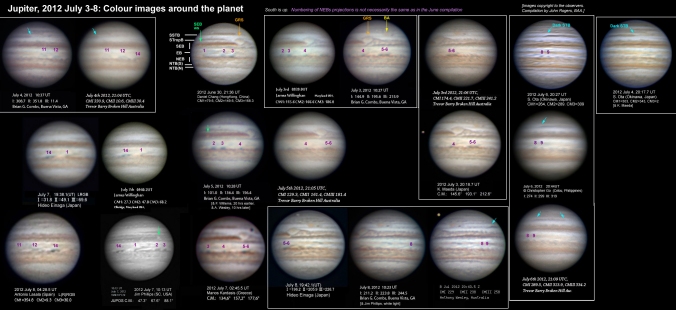
_________________________________
John H. Rogers, Ph.D. Jupiter Section Director,
British Astronomical Association
jhr11@cam.ac.uk
http://www.britastro.org/jupiter/
[2] Jupiter's northern upheavals coming into focus (July 2012.)
2012/13
report no.1:
Jupiter's
northern upheavals coming into focus
Observers are now producing images of ever-improving quality as Jupiter moves
higher in the morning sky. Attached is a compilation of colour images covering
July 3-8, with some key features marked. (I can send an unlabelled version, and
a compilation of near-IR images, to anyone who would like them.)
Congratulations to all observers, and also thanks to the ALPO-Japan, from whose
web site some of the best images are taken.
The great upheavals on the NTB and NEB are now much better seen. Revivals
of both belts are indeed proceeding dramatically. The whole region is very
complex, with disturbance spanning the NTropZ.
The revived NTB(S) is a striking dark orange belt at most longitudes, although
it is still weak from L1 ~ 40-120 (L2 ~ 60-150). (This sector seems to be moving
with System I, although its boundaries are too indefinite for actual tracking.)
There is a separate dark grey NTB(N), everywhere except L2 = 60-106, with some
darker sectors.
The NTropZ is filled with pale fawn colour plus dark grey spots and streaks.
(These are not as distinct as in June so it is not yet clear if they are the
same ones.)
The NEB is very complex at all longitudes, pale except for a narrow dark NEB(S),
with much internal turbulence. I can no longer identify any specifically
disturbed sector as the source of disturbance. On the NEBs edge, there are
many diverse dark formations. I have numbered them for convenience, but cannot
guarantee that these numbers match those used in June, as we have not yet
tracked them. A closer study of the most active sector, L1 ~ 260-360, which was
passing the most disturbed NEB sector in June, shows rapid changes: some
ill-defined blue-grey streaks on NEBs crystallised into a chain of small
projections at L1 <~295 (June 27, July 6), while the sector f. them is very
disturbed, including bright white spots and very dark blue-grey spots erupting
on the NEBs. The unusual brown sector of EZ(N), which enveloped dark features
13-14, disappeared as these spots intruded on it; but reddish colour has
spread from the NEB into the EZ(N) in other sectors, esp. around dark features
5-6.
There is also an orange-brown Eq.Band at most longitudes, with some dark grey
streaks in it. This seems to be the most distinct equatorial coloration event
since 1989-91, and it could continue to grow. The source of the reddish
material is an outstanding puzzle: e.g., does it condense diffusely, or is it
created in vigorous plumes/festoons from the NEBs disturbances?
The southern hemisphere is mercifully normal by contrast. The SEB has the
normal rifting f. the GRS. The dark S.Trop.Band has now detached from the
p. end of the GRS. The GRS is probably losing its dark S rim as a
consequence and thus returning to the normal 'Voyager' aspect, although it is
internally pale this year. In contrast, oval BA (which is approaching the
GRS) has reverted to a strong red colour.

_________________________________
John H. Rogers, Ph.D. Jupiter Section Director,
British Astronomical Association
jhr11@cam.ac.uk
http://www.britastro.org/jupiter/